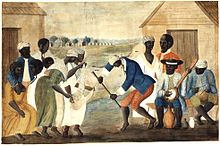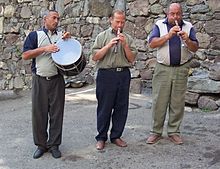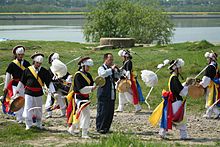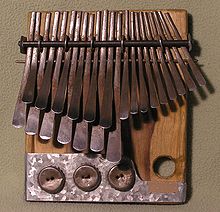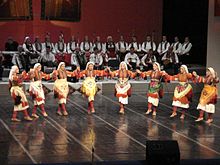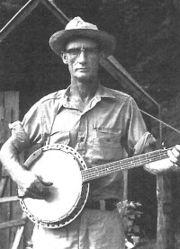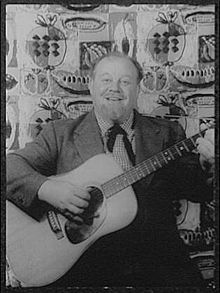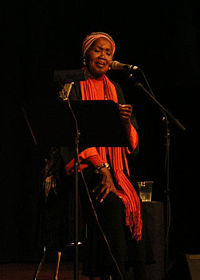- Folk music
-
"Folk song" redirects here. For other uses, see Folk song (disambiguation).
Folk music 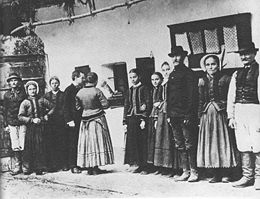
Béla Bartók recording Slovak peasant singers in 1908Traditions List of folk music traditions Musicians List of folk musicians Instruments Folk instruments Folk music is an English term encompassing both traditional folk music and contemporary folk music. The term originated in the 19th century. Traditional folk music has been defined in several ways: as music transmitted by mouth, as music of the lower classes, and as music with unknown composers. It has been contrasted with commercial and classical styles. This music is also referred to as traditional music and, in US, as "roots music".
Starting in the mid-20th century a new form of popular folk music evolved from traditional folk music. This process and period is called the (second) folk revival and reached a zenith in the 1960s. The most common name for this new form of music is also "folk music", but is often called "contemporary folk music" or "folk revival music" to make the distinction.[1] This type of folk music also includes fusion genres such as folk rock, electric folk, and others. While contemporary folk music is a genre generally distinct from traditional folk music, it often shares the same English name, performers and venues as traditional folk music; even individual songs may be a blend of the two.
Contents
- 1 Traditional folk music
- 2 Contemporary folk music
- 3 Notable venues
- 4 See also
- 5 Notes & References
- 6 References
- 7 Further reading
- 8 External links
Traditional folk music
Definitions
A consistent definition of traditional folk music is elusive. The terms folk music, folk song, and folk dance are comparatively recent expressions. They are extensions of the term folk lore, which was coined in 1846 by the English antiquarian William Thoms to describe "the traditions, customs, and superstitions of the uncultured classes."[2] The term is further derived from the German expression Volk, in the sense of "the people as a whole" as applied to popular and national music by Johann Gottfried Herder and the German Romantics over half a century earlier.[3] Traditional folk music also includes most indigenous music
However, despite the assembly of an enormous body of work over some two centuries, there is still no certain definition of what folk music (or folklore, or the folk) is.[4] Folk music may tend to have certain characteristics[2] but it cannot clearly be differentiated in purely musical terms. One meaning often given is that of "old songs, with no known composers",[5] another is that of music that has been submitted to an evolutionary "process of oral transmission.... the fashioning and re-fashioning of the music by the community that give it its folk character."[6] Such definitions depend upon "(cultural) processes rather than abstract musical types...", upon "continuity and oral transmission...seen as characterizing one side of a cultural dichotomy, the other side of which is found not only in the lower layers of feudal, capitalist and some oriental societies but also in 'primitive' societies and in parts of 'popular cultures'."[7] One widely used definition is simply "Folk music is what the people sing".[8]
For Scholes,[2] as well as for Cecil Sharp and Béla Bartók,[9] there was a sense of the music of the country as distinct from that of the town. Folk music was already "seen as the authentic expression of a way of life now past or about to disappear (or in some cases, to be preserved or somehow revived),"[10] particularly in "a community uninfluenced by art music"[6] and by commercial and printed song. Lloyd rejected this in favour of a simple distinction of economic class[9] yet for him true folk music was, in Charles Seeger's words, "associated with a lower class[11] in societies which are culturally and socially stratified, that is, which have developed an elite, and possibly also a popular, musical culture." In these terms folk music may be seen as part of a "schema comprising four musical types: 'primitive' or 'tribal'; 'elite' or 'art'; 'folk'; and 'popular'."[12]
Characteristics
From a historical perspective, traditional folk music had these characteristics:[11]
- It was transmitted through an oral tradition. Before the twentieth century, ordinary farm workers and factory workers were usually illiterate. They acquired songs by memorizing them. Primarily, this was not mediated by books, recorded or transmitted media. Singers may extend their repertoire using broadsheets, song books or CDs, but these secondary enhancements are of the same character as the primary songs experienced in the flesh.
- The music was often related to national culture. It was culturally particular - from a particular region or culture. In the context of an immigrant group, folk music acquires an extra dimension for social cohesion. It is particularly conspicuous in the United States, where Polish-Americans, Irish-Americans, Asian-Americans and others strive to emphasis differences from the mainstream. They will learn songs and dances that originate in the countries where their grandparents came from.
- They commemorate historical and personal events. On certain days of the year, such as Easter, May Day and Christmas, particular songs celebrate the yearly cycle. Weddings, birthdays and funerals may also be noted with songs, dances and special costumes. Religious festivals often have a folk music component. Choral music at these events brings children and non-professional singers to participate in a public arena, giving an emotional bonding that is unrelated to the aesthetic qualities of the music.
- The songs have been performed, by custom, over a long period of time, usually several generations.
As a side-effect, the following characteristics are sometimes present:
- The is no copyright on the songs. There are hundreds of folk songs from the nineteenth century which have known authors. However, they have continued in oral tradition, to the point where they are classified as "Traditional", for purposes of music publishing. This has become much less frequent since the 1970s. Today, almost every folk song that is recorded is credited with an arrangement.
- Fusion of cultures. In the same way that people can have a mixed background, with parents originating in different continents, so too music can be a blend of influences. A particular rhythmic pattern, or a characteristic instrument, is enough to give a traditional feel to music, even when it has been composed recently. It is easy to recognize the presence of a bagpipe or a tabla in a piece of music. The young are usually much less offended by the dilution or adaptation of songs this way. Equally an electric guitar can be added to an old song. The relevant factors may include instrumentation, tunings, voicings, phrasing, subject matter, and even production methods.
Origins
Throughout most of human prehistory and history, listening to recorded music was not possible. One origin is the work of economic production which was often manual and communal. Music was made by common people during both their work and leisure. Manual labor often included singing by the workers, which served several practical purposes. It reduced the boredom of repetitive tasks, it kept the rhythm during synchronized pushes and pulls, and it set the pace of many activities such as planting, weeding, reaping, threshing, weaving, and milling. In leisure time, singing and playing musical instruments were common forms of entertainment and history-telling—even more common than today, when electrically enabled technologies and widespread literacy make other forms of entertainment and information-sharing competitive.[13]
Opinions differed over the origins of folk music: it was said by some to be art music changed and probably debased by oral transmission, by others to reflect the character of the race that produced it.[2] Traditionally, the cultural transmission of folk music is through playing by ear, although notation may also be used. The competition of individual and collective theories of composition set different demarcations and relations of folk music with the music of tribal societies on the one hand and of "art" and "court" music on the other. The traditional cultures that did not rely upon written music or had less social stratification could not be readily categorized. In the proliferation of popular music genres, some traditional folk music became also referred to "World music" or "Roots music".
The English term "folklore", to describe traditional folk music and dance, entered the vocabulary of many continental European nations, each of which had its folk-song collectors and revivalists.[2] The distinction between "authentic" folk and national and popular song in general has always been loose, particularly in America and Germany[2] - for example popular songwriters such as Stephen Foster could be termed "folk" in America.[2][14] The International Folk Music Council definition allows that the term "can also be applied to music which has originated with an individual composer and has subsequently been absorbed into the unwritten, living tradition of a community. But the term does not cover a song, dance, or tune that has been taken over ready-made and remains unchanged."[15]
The post–World War II folk revival in America and in Britain started a new genre, contemporary folk music and brought an additional meaning to the term folk music. The popularity of "contemporary folk" recordings caused the appearance of the category "Folk" in the Grammy Awards of 1959: in 1970 the term was dropped in favor of "Best Ethnic or Traditional Recording (including Traditional Blues)", while 1987 brought a distinction between "Best Traditional Folk Recording" and "Best Contemporary Folk Recording". After that they had a "Traditional music" category which subsequently evolved into others. The term "folk", by the start of the 21st century, could cover singer song-writers, such as Donovan and Bob Dylan, who emerged in the 1960s and much more. This completed a process to where "folk music" no longer meant only traditional folk music.[5]
Subject matter
Apart from instrumental music that forms a part of traditional folk music, especially dance music traditions, much traditional folk music is vocal music, since the instrument that makes such music is usually handy. As such, most traditional folk music has meaningful lyrics.
Narrative verse looms large in the traditional folk music of many cultures. This encompasses such forms as traditional epic poetry, much of which was meant originally for oral performance, sometimes accompanied by instruments. Many epic poems of various cultures were pieced together from shorter pieces of traditional narrative verse, which explains their episodic structure and often their in medias res plot developments. Other forms of traditional narrative verse relate the outcomes of battles and other tragedies or natural disasters. Sometimes, as in the triumphant Song of Deborah found in the Biblical Book of Judges, these songs celebrate victory. Laments for lost battles and wars, and the lives lost in them, are equally prominent in many traditions; these laments keep alive the cause for which the battle was fought. The narratives of traditional songs often also remember folk heroes such as John Henry to Robin Hood. Some traditional song narratives recall supernatural events or mysterious deaths.
Hymns and other forms of religious music are often of traditional and unknown origin. Western musical notation was originally created to preserve the lines of Gregorian chant, which before its invention was taught as an oral tradition in monastic communities. Traditional songs such as Green grow the rushes, O present religious lore in a mnemonic form. In the Western world, Christmas carols and other traditional songs preserve religious lore in song form.
Work songs frequently feature call and response structures and are designed to enable the labourers who sing them to coordinate their efforts in accordance with the rhythms of the songs. They are frequently, but not invariably, composed. In the American armed forces, a lively tradition of jody calls ("Duckworth chants") are sung while soldiers are on the march. Professional sailors made use of a large body of sea shanties. Love poetry, often of a tragic or regretful nature, prominently figures in many folk traditions. Nursery rhymes and nonsense verse also are frequent subjects of traditional songs.
Folk song transformations and variations
See also: List of folk music traditionsMusic transmitted by word of mouth through a community will, in time, develop many variants, because this kind of transmission cannot produce word-for-word and note-for-note accuracy. Indeed, many traditional singers are quite creative and deliberately modify the material they learn.
For example the words of "I'm a Man You Don't Meet Every Day" (Roud 975) are known from a broadside in the Bodleian Library.[16] The date is almost certainly before 1900, and it seems to be Irish. In 1958 the song was recorded in Canada (My Name is Pat and I'm Proud of That). Jeannie Robertson made the next recorded version in 1961. She has changed it to make reference to "Jock Stewart", one of her relatives, and there are no Irish references. In 1976 Archie Fisher deliberately altered the song to remove the reference to a dog being shot. In 1985 The Pogues took it full circle by restoring all the Irish references.
Because variants proliferate naturally, it is naive to believe that there is such a thing as the single "authentic" version of a ballad such as "Barbara Allen". Field researchers in traditional song (see below) have encountered countless versions of this ballad throughout the English-speaking world, and these versions often differ greatly from each other. None can reliably claim to be the original, and it is quite possible that whatever the "original" was, it ceased to be sung centuries ago. Any version can lay an equal claim to authenticity, so long as it is truly from a traditional singing community and not the work of an outside editor.
Cecil Sharp had an influential idea about the process of folk variation: he felt that the competing variants of a traditional song would undergo a process akin to biological natural selection: only those new variants that were the most appealing to ordinary singers would be picked up by others and transmitted onward in time. Thus, over time we would expect each traditional song to become aesthetically ever more appealing — it would be collectively composed to perfection, as it were, by the community.
A literary interest in the popular ballad was not new; it dates back to Thomas Percy and William Wordsworth. English Elizabethan and Stuart composers had often evolved their music from folk themes, the classical suite was based upon stylised folk-dances and Joseph Haydn's use of folk melodies is noted. But the emergence of the term "folk" coincided with an "outburst of national feeling all over Europe" that was particularly strong at the edges of Europe, where national identity was most asserted. Nationalist composers emerged in Eastern Europe, Russia, Scandinavia, Spain and Britain: the music of Dvorak, Smetana, Grieg, Rimsky-Korsakov, Brahms, Liszt, de Falla, Wagner, Sibelius, Vaughan Williams, Bartók and many others drew upon folk melodies.
Regional forms
While the loss of traditional folk music in the face of the rise of popular music is a worldwide phenomenon, it is not one occurring at a uniform rate throughout the world. While even many tribal cultures are losing traditional folk music and folk cultures, the process is most advanced "where industrialization and commercialisation of culture are most advanced".[17] Yet in nations or regions where traditional folk music is a badge of cultural or national identity, the loss of traditional music can be slowed; this is held to be true, for instance in the case of Bangladesh, Hungary, India, Ireland, Latvia, Turkey, Portugal, Brittany, and Galicia, Greece and Crete all of which retain their traditional music to some degree, in some such areas the decline of traditional music and loss of traditions has been reversed.
Fieldwork and scholarship
19th century Europe
Starting in the 19th century, interested people - academics and amateur scholars - started to take note of what was being lost, and there grew various efforts aimed at preserving the music of the people. One prominent such effort was the collection by Francis James Child in the late 19th century of the texts of over three hundred ballads in the English and Scots traditions (called the Child Ballads) most of which predated the sixteenth century.[18]
Contemporaneously with Child came the Reverend Sabine Baring-Gould, and later and more significantly Cecil Sharp who worked in the early 20th century to preserve a great body of English rural traditional song, music and dance, under the aegis of what became and remains the English Folk Dance and Song Society (EFDSS). Sharp also worked in America, recording the traditional songs of the Appalachian Mountains in 1916-1918 in collaboration with Maud Karpeles and Olive Dame Campbell and is considered the first major scholar covering American folk music.[19] Campbell and Sharp are represented under other names by actors in the modern movie Songcatcher. Throughout the 1960s and early to mid-1970s, American scholar Bertrand Harris Bronson published an exhaustive, four-volume collection of the then-known variations of both the texts and tunes associated with what came to be known as the Child Canon. He also advanced some significant theories concerning the workings of oral-aural tradition.
Similar activity was also under way in other countries. One of the most extensive was perhaps the work done in Riga by Krisjanis Barons who between the years between 1894 and 1915 published six volumes including the texts of 217 996 Latvian folk songs; the Latvju dainas.
Around this time, composers of classical music developed a strong interest in traditional song collecting, and a number of outstanding composers carried out their own field work on traditional song. These included Percy Grainger and Ralph Vaughan Williams in England and Béla Bartók in Hungary. These composers, like many of their predecessors, incorporated traditional material into their classical compositions. The Latviju dainas are extensively used in the classical choral works of Andrejs Jurāns, Jānis Cimze, and Emilis Melngailis.
North America
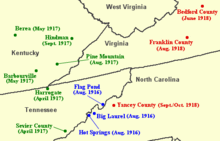 Locations in Southern and Central Appalachia visited by the British folklorist Cecil Sharp in 1916 (blue), 1917 (green), and 1918 (red). Sharp sought "old world" English and Scottish ballads passed down to the region's inhabitants from their British ancestors. He collected hundreds of such ballads, the most productive areas being the Blue Ridge Mountains of North Carolina and the Cumberland Mountains of Kentucky
Locations in Southern and Central Appalachia visited by the British folklorist Cecil Sharp in 1916 (blue), 1917 (green), and 1918 (red). Sharp sought "old world" English and Scottish ballads passed down to the region's inhabitants from their British ancestors. He collected hundreds of such ballads, the most productive areas being the Blue Ridge Mountains of North Carolina and the Cumberland Mountains of Kentucky
Earliest American scholars were with the The American Folklore Society (AFS) which emerged in the late 1800s. Their studies expanded to include Native American music, but still treated folk music as a historical item preserved in isolated societies.[20] In North America, during the 1930s and 1940s, the Library of Congress worked through the offices of traditional music collectors Robert Winslow Gordon, Alan Lomax and others to capture as much North American field material as possible. Lomax was the first prominent scholar to study distinctly American folk music such as that of cowboys and southern blacks. His first major published work was in 1911, Cowboy songs.[21]
People who studied traditional song sometimes hoped that their work would restore traditional music to the people. For instance, Cecil Sharp campaigned, with some success, to have English traditional songs (in his own heavily edited and expurgated versions) to be taught to school children.
One strong theme amongst folk scholars in the early decades of the the 20th century was regionalism. This tended to recognize the diversity of folk music (and related cultures) based on regions of the US rather than based on just its roots. Later, a dynamic of class and circumstances was added to this. [22] The most prominent regionalists were literary figures with a particular interest in folklore. Carl Sandberg often traveled the USA as a writer and a poet. He also collected songs in his travels and, in 1927, published them in a book American Songbag. "In his collections of folk songs, Sandburg added a class dynamic to popular understandings of American folk music. This was the final element of the foundation upon which the early folk music revivalists constructed their own view of Americanism. Sandberg's working class Americans joined with the ethnically racially and regionally diverse citizens that other scholars, public intellectuals, and folklorists celebrated their own definitions of the American folk, definitions that the folk revivalists used inn constructing their own understanding of American folk music, and an overarching American identity" [23]
One theme that runs through the great period of scholarly traditional song collection is the tendency of certain members of the "folk", who were supposed to be the object of study, to become scholars and advocates themselves. For example, Jean Ritchie was the youngest child of a large family from Viper, Kentucky that had preserved many of the old Appalachian traditional songs. Ritchie, living in a time when the Appalachians had opened up to outside influence, was university educated and ultimately moved to New York City, where she made a number of classic recordings of the family repertoire and published an important compilation of these songs. (See also Hedy West)
National and regional forms
Africa
Main article: Music of AfricaAfrica is a vast continent and its regions and nations have distinct musical traditions. The music of North Africa for the most part has a different history from Sub-Saharan African music traditions.[24]
The music and dance forms of the African diaspora, including African American music and many Caribbean genres like soca, calypso and Zouk; and Latin American music genres like the samba, rumba, salsa; and other clave (rhythm)-based genres, were founded to varying degrees on the music of African slaves, which has in turn influenced African popular music.
Asia
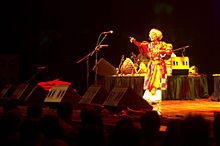 Paban Das Baul, baul singer at Nine Lives concert, 2009.
Paban Das Baul, baul singer at Nine Lives concert, 2009.
Many Asian civilizations distinguish between art/court/classical styles and "folk" music, though cultures that do not depend greatly upon notation and have much anonymous art music must distinguish the two in different ways from those suggested by western scholars. For example the late Alam Lohar is a good example of a classical South Asian folk singer of great repute.[citation needed]
Australia
See also: Australian folk music and Indigenous Australian musicFolk song traditions were taken to Australia by early settlers from Britain and Ireland and gained particular foothold in the rural outback. The rhyming songs, poems and tales written in the form of bush ballads often relate to the itinerant and rebellious spirit of Australia in The Bush, and the authors and performers are often referred to as bush bards.[25] The 19th century was the golden age of bush ballads. Several collectors have catalogued the songs including John Meredith whose recording in the 1950s became the basis of the collection in the National Library of Australia.[25] The songs tell personal stories of life in the wide open country of Australia. Typical subjects include mining, raising and droving cattle, sheep shearing, wanderings, war stories, the 1891 Australian shearers' strike, class conflicts between the landless working class and the squatters (landowners), and outlaws such as Ned Kelly, as well as love interests and more modern fare such as trucking.[26] The most famous bush ballad is "Waltzing Matilda", which has been called "the unofficial national anthem of Australia".[27]
Indigenous Australian music includes the music of Australian Aborigines and Torres Strait Islanders, who are collectively called Indigenous Australians; it incorporates a variety of distinctive traditional music styles practiced by Indigenous Australian peoples, as well as a range of contemporary musical styles of and fusion with European traditions as interpreted and performed by indigenous Australian artists. Music has formed an integral part of the social, cultural and ceremonial observances of these peoples, down through the millennia of their individual and collective histories to the present day. The traditional forms include many aspects of performance and musical instrumentation which are unique to particular regions or Indigenous Australian groups; there are equally elements of musical tradition which are common or widespread through much of the Australian continent, and even beyond. The culture of the Torres Strait Islanders is related to that of adjacent parts of New Guinea and so their music is also related. Music is a vital part of Indigenous Australians' cultural maintenance.[28]
Europe
See also: Turkish folk music, Greek folk music, French folk music, English folk music, Swedish folk music, Italian folk music, Icelandic folk music, Sami music, Nordic folk music, and Romani musicCeltic traditional music
See also: Folk music of IrelandCeltic music is a term used by artists, record companies, music stores and music magazines to describe a broad grouping of musical genres that evolved out of the folk musical traditions of the Celtic peoples of Western Europe. These traditions include Irish, Scottish, Manx, Cornish, Welsh, Breton traditions. Galician music is often included, though significant research showing that this has any close musical relationship is lacking. Brittany's Folk revival began in the 1950s with the "bagadoù" and the "kan-ha-diskan" before growing to world fame through Alan Stivell's work since the mid-1960s.[29]
In Ireland, The Clancy Brothers and Tommy Makem (although its members were all Irish-born, the group became famous while based in New York's Greenwich Village), The Dubliners, Clannad, Planxty, The Chieftains, The Pogues, The Irish Rovers, and a variety of other folk bands have done much over the past few decades to revitalise and re-popularise Irish traditional music. These bands were rooted, to a greater or lesser extent, in a living tradition of Irish music and benefited from the efforts of artists such as Seamus Ennis and Peter Kennedy.[29]
Eastern Europe
See also: Music of Eastern EuropeDuring the Communist era national folk dancing was actively promoted by the state. Dance troupes from Russia and Poland toured Western Europe from about 1937 to 1990. The Red Army Choir recorded many albums. A female choir from Bulgarian State Radio recorded "Le Mystere des Voix Bulgares".
The Hungarian group Muzsikás played numerous American tours and participated in the Hollywood movie The English Patient while the singer Márta Sebestyén worked with the band Deep Forest. The Hungarian táncház movement, started in the 1970s, involves strong cooperation between musicology experts and enthusiastic amateurs.[citation needed] However, traditional Hungarian folk music and folk culture barely survived in some rural areas of Hungary, and it has also begun to disappear among the ethnic Hungarians in Transylvania. The ttáncházmovement revived broader folk traditions of music, dance, and costume together and created a new kind of music club. The movement spread to ethnic Hungarian communities elsewhere in the world.
Balkan music
See also: Balkan musicThe Balkan folk music was influenced by the mingling of Balkan ethnic groups in the period of Ottoman Empire. It comprises the music of Bosnia and Herzegovina, Croatia, Bulgaria, Greece, Montenegro, Serbia, Romania, Slovenia, Republic of Macedonia, Albania, Turkey, the historical states of Yugoslavia or the State Union of Serbia and Montenegro and geographical regions such as Thrace. Some music is characterised by complex rhythm. An important part of the whole Balkan folk music is the music of the local Romani ethnic minority.
Nordic folk music
See also: Nordic folk music, Traditional Nordic dance music, Swedish folk music, Icelandic folk music, Sami music, Yoik, Nyckelharpa, and KanteleNordic folk music includes a number of traditions in Northern European, especially Scandinavian, countries. The Nordic countries are generally taken to include Iceland, Norway, Finland, Sweden and Denmark. Sometimes it is taken to include Greenland and historically the Baltic countries of Estonia, Latvia and Lithuania.
The many regions of the Nordic countries share certain traditions, many of which have diverged significantly. It is possible to group together the Baltic states (or, sometimes, only Estonia) and parts of northwest Russia as sharing cultural similarities, contrasted with Norway, Sweden, Denmark and the Atlantic islands of, Iceland and the Faroe Islands. Greenland's Inuit culture has its own musical traditions, influenced by Scandinavian culture. Finland shares many cultural similarities with both the Baltic nations and the Scandinavian nations. The Saami of Sweden, Norway, Finland and Russia have their own unique culture, with ties to the neighboring cultures.
Swedish folk music
Swedish folk music is a genre of music based largely on folkloric collection work that began in the early 19th century in Sweden.[30] The primary instrument of Swedish folk music is the fiddle. Another common instrument, unique to Swedish traditions, is the nyckelharpa. Most Swedish instrumental folk music is dance music; the signature music and dance form within Swedish folk music is the polska. Vocal and instrumental traditions in Sweden have tended to share tunes historically, though they have been performed separately.[31] Beginning with the folk music revival of the 1970s, vocalists and instrumentalists have also begun to perform together in folk music ensembles.
Latin and South America
Andean music comes from the general area inhabited by Quechuas, Aymaras and other peoples that roughly in the area of the Inca Empire prior to European contact. It includes folklore music of parts of Argentina, Bolivia, Ecuador, Chile, Colombia, Peru and Venezuela. Andean music is popular to different degrees across Latin America, having its core public in rural areas and among indigenous populations. The Nueva Canción movement of the 70s revived the genre across Latin America and bought it to places where it was unknown or forgotten.
Nueva canción (Spanish for 'new song') is a movement and genre within Latin American and Iberian music of folk music, folk-inspired music and socially committed music. It some respects its development and role is similar to the second folk music revival. This includes evolution of this new genre from traditional folk music, essentially contemporary folk music except that that English genre term is not commonly applied to it. Nueva cancion is recognized as having played a powerful role in the social upheavals in Portugal, Spain and Latin America during the 1970s and 1980s.
Nueva cancion first surfaced during the 1960s as "The Chilean New Song" in Chile. The musical style emerged shortly afterwards in Spain and other areas of Latin America where it came to be known under similar names. Nueva canción renewed traditional Latin American folk music, and was soon associated with revolutionary movements, the Latin American New Left, Liberation Theology, hippie and human rights movements due to political lyrics. It would gain great popularity throughout Latin America, and is regarded as a precursor to Rock en español.
Cueca is a family of musical styles and associated dances from Chile, Bolivia, Peru, and Argentina.
North America
USA
See also: American folk musicAmerican traditional music is also called roots music. Roots music is a broad category of music including bluegrass, country music, gospel, old time music, jug bands, Appalachian folk, blues, Cajun and Native American music. The music is considered American either because it is native to the United States or because it developed there, out of foreign origins, to such a degree that it struck musicologists as something distinctly new. It is considered "roots music" because it served as the basis of music later developed in the United States, including rock and roll, contemporary folk music, rhythm and blues, and jazz.
Cajun music, an emblematic music of Louisiana, is rooted in the ballads of the French-speaking Acadians of Canada. Cajun music is often mentioned in tandem with the Creole-based, Cajun-influenced zydeco form, both of Acadiana origin. These French Louisiana sounds have influenced American popular music for many decades, especially country music, and have influenced pop culture through mass media, such as television commercials.
Appalachian music is the traditional music of the region of Appalachia in the Eastern United States. It is derived from various European and African influences, including English ballads, Irish and Scottish traditional music (especially fiddle music), religious hymns, and African-American blues. First recorded in the 1920s, Appalachian musicians were a key influence on the early development of Old-time music, country music, and bluegrass, and were an important part of the American folk music revival. Instruments typically used to perform Appalachian music include the banjo, American fiddle, fretted dulcimer, and guitar.[32]
Early recorded Appalachian musicians include Fiddlin' John Carson, Henry Whitter, Bascom Lamar Lunsford, the Carter Family, Clarence Ashley, Frank Proffitt, and Dock Boggs, all of whom were initially recorded in the 1920s and 1930s. Several Appalachian musicians obtained renown during the folk revival of the 1950s and 1960s, including Jean Ritchie, Roscoe Holcomb, Ola Belle Reed, Lily May Ledford, and Doc Watson. Country and bluegrass artists such as Loretta Lynn, Roy Acuff, Dolly Parton, Earl Scruggs, Chet Atkins, and Don Reno were heavily influenced by traditional Appalachian music.[32] Artists such as Bob Dylan, Jerry Garcia, and Bruce Springsteen have performed Appalachian songs or rewritten versions of Appalachian songs.
The Carter Family was a traditional American folk music group that recorded between 1927 and 1956. Their music had a profound impact on bluegrass, country, Southern Gospel, pop and rock musicians. They were the first vocal group to become country music stars; a beginning of the divergence of country music from traditional folk music. Their recordings of such songs as "Wabash Cannonball", "Will the Circle Be Unbroken", "Wildwood Flower" and "Keep On the Sunny Side" made them country standards.[33]
Canada
See also: Music of Canada and French-Canadian musicCanada's traditional folk music is particularly diverse.[34] "Traditional folk music of European origin has been present in Canada since the arrival of the first French and British settlers in the 16th and 17th centuries."[34] "They fished the coastal waters and farmed the shores of what became Newfoundland, Nova Scotia, New Brunswick, Prince Edward Island, and the St Lawrence River valley of Quebec."[34]
The fur trade and its voyageurs brought this farther north and west into Canada; later lumbering operations and lumberjacks continued this process.[34]
"Agrarian settlement in eastern and southern Ontario and western Quebec in the early 19th century established a favorable milieu for the survival of many Anglo-Canadian folksongs and broadside ballads from Great Britain and the USA. Despite massive industrialization, folk music traditions have persisted in many areas until today. In the north of Ontario, a large Franco-Ontarian population kept folk music of French origin alive. Populous Acadian communities in the Atlantic provinces contributed their song variants to the huge corpus of folk music of French origin centred in the province of Quebec. A rich source of Anglo-Canadian folk music can be found in the Atlantic region, especially Newfoundland. Completing this mosaic of musical folklore is the Gaelic music of Scottish settlements, particularly in Cape Breton, and the hundreds of Irish songs whose presence in eastern Canada dates from the Irish famine of the 1840s which forced the large migrations of Irish to North America."[34]
"Knowledge of the history. of Canada is essential in understanding the mosaic of Canadian folk song. Part of this mosaic is supplied by the folk songs of Canada which were brought by European and Anglo-Saxon settlers to the new land. Cartier's historical journey, in 1535, to the territory that was to become Canada initiated the immigration of the French. Without too much delay people came from Great Britain, Germany, and other European countries to live in close proximity. Each brought a wealth of folk music from his homeland and some of it has survived to this day. Barbeau has estimated that well over ten thousand French folk songs and their variants have been collected in Canada. Many of the ancient ones have been forgotten in France."[11]
Traditional folk music revivals
"Folk revival" most commonly refers to two particular phenomena; the British folk revival of approximately 1890-1920, and the folk revival of the mid 20th century which started new genres of folk music. But earlier events have also sometimes been referred to as folk revivals.
One such earlier one influenced western classical music. Such composers as Percy Grainger, Ralph Vaughan Williams and Béla Bartók, made field recordings or transcriptions of folk singers and musicians.
In Spain, Isaac Albéniz (1860–1909) produced piano works reflect his Spanish heritage, including the Suite Iberia (1906–1909). Enrique Granados (1867–1918) composed zarzuela, Spanish light opera, and Danzas Españolas - Spanish Dances. Manuel de Falla (1876–1946) became interested in the cante jondo of Andalusian flamenco, the influence of which can be strongly felt in many of his works, which include Nights in the Gardens of Spain and Siete canciones populares españolas ("Seven Spanish Folksongs", for voice and piano). Composers such as Fernando Sor and Francisco Tarrega established the guitar as Spain's national instrument. Modern Spanish folk artists abound (Mil i Maria, Russian Red, et al.) modernizing whilst respecting the traditions of their forebears.
Flamenco grew in popularity through the 20th century, as did northern styles such as the Celtic music of Galicia. French classical composers, from Bizet to Ravel, also drew upon Spanish themes, and distinctive Spanish genres became universally recognised.
First British folk revival
The "first" British folk revival was a roots revival which occurred approximately 1890 -1920 and was marked by heightened interest in traditional music and its preservation. It arose from earlier developments, perhaps combined with changes in the nature of British identity, led to a much more intensive and academic attempt to record what was seen as a vanishing tradition, and is now usually referred to as the first English or British folk revival.
Contemporary folk music
Starting in the mid-20th century a new form of popular folk music evolved from traditional folk music. This process and period is called the (second) folk revival and reached a zenith in the 1960s. The most common name for this new form of music is also "folk music", but is often called "contemporary folk music" or "folk revival music" to make the distinction.[1] This type of folk music also includes fusion genres such as folk rock, electric folk, and others. While contemporary folk music is a genre generally distinct from traditional folk music, it often shares the same English name, performers and venues as traditional folk music; even individual songs may be a blend of the two.
Definitions of "contemporary folk music" are generally vague and variable. Here it is taken to mean all music that is called folk which is not traditional music; a set of genres which began with and then evolved from the folk revival of the mid-20th century. According to Hugh Blumenfeld, for the American folk scene, in general it is:
- "Anglo-American, embracing acoustic and/or tradition-based music from the U.K. and the United States.
- Musically, it is mainly Western European in its origins; linguistically, it is predominantly English-based.
- The few exceptions to the above are based mainly on prevailing political/historical conditions in the Anglo-American world and the demographics of folk fans: Celtic music, blues, some Central and South American music, Native American music, and Klezmer."[35] With "folk music" being an particularly English term, this definition may have general relevance. This is the common use of the term contemporary folk music (and the subject of this section), but is not the only case of evolution of new forms of folk music from traditional folk music. Nueva canción, a similar evolution of a new form of socially committed music occurred in several Spanish speaking countries. New forms of traditional music emerge elsewhere to someday become themselves traditional folk music.
Contemporary country music descends ultimately from a rural American folk tradition, but has evolved differently. Bluegrass music is a professional development of American old time music, intermixed with blues and jazz.
Folk revival of the mid 20th century in Britain and America
See also: American folk music revival and British folk revivalWhile the Romantic nationalism of the folk revival had its greatest influence on art-music, the "second folk revival" of the later 20th century brought a new genre of popular music with artists marketed by amplified concerts, recordings and broadcasting. This is the genre that remains as folk music even when traditional music is considered to be a separate genre. One of the earliest figures in this revival was Woody Guthrie.[36] The American Woody Guthrie collected folk music in the 1930s and 1940s and also composed his own songs, as did Pete Seeger. In the 1930s Jimmie Rodgers, in the 1940s Burl Ives, in the early 1950s Seeger's group The Weavers and Harry Belafonte, and in the late 1950s The Kingston Trio as well as other professional, commercial groups became popular. In 1963–1964, the ABC television network aired the Hootenanny television series devoted to this brand of folk music and also published the associated magazine ABC-TV Hootenanny. Starting in 1950 the Sing Out!, Broadside, and The Little Sandy Review magazines helped spread both traditional and composed songs, as did folk-revival-oriented record companies.
In the United Kingdom, the folk revival fostered young artists like The Watersons, Martin Carthy and Roy Bailey and a generation of singer-songwriters such as Bert Jansch, Ralph McTell, Donovan and Roy Harper; all seven entered the public eye in the 1960s. Bob Dylan, Paul Simon and Tom Paxton visited Britain for some time in the early 1960s, the first two, particularly, making later use of the traditional English material they heard.
In 1950, Alan Lomax came to Britain and met A.L. 'Bert' Lloyd and Ewan MacColl, a meeting credited as inaugurating the second British folk revival. In London the colleagues opened The Ballads and Blues Club, eventually renamed the Singers' Club, possibly the first folk club; it closed in 1991. As the 1950s progressed into the 1960s, the folk revival movement built up in both Britain and America. The mid and late 1960s saw fusion forms of folk (such as folk rock) achieve prominence never before seen by folk music, but the early 1960s were perhaps the zenith of non-fusion folk music prominence in the music scene.
Major performers who emerged from the 1940s to the early 1960s
Some major folk music performers who emerged during 1940s, 1950s and early 1960s were:
- Woody Guthrie (1912 –1967) is best known as an American singer-songwriter and folk musician, whose musical legacy includes hundreds of political, traditional and children's songs, ballads and improvised works. He frequently performed with the slogan This Machine Kills Fascists displayed on his guitar. His best-known song is "This Land Is Your Land". Many of his recorded songs are archived in the Library of Congress.[37] In the 1930s Guthrie traveled with migrant workers from Oklahoma to California while learning, rewriting, and performing traditional folk and blues songs along the way. Many the songs he composed were about his experiences in the Dust Bowl era during the Great Depression, earning him the nickname the "Dust Bowl Balladeer".[38] Throughout his life, Guthrie was associated with United States communist groups, though he was never formally joined the Party.[39] Guthrie fathered American folk musician Arlo Guthrie. During his later years Guthrie served as a figurehead in the folk movement, providing inspiration to a generation of new folk musicians, including mentor relationships with Ramblin' Jack Elliott and Bob Dylan. Such songwriters as Bob Dylan, Phil Ochs, Bruce Springsteen, Pete Seeger, Joe Strummer and Tom Paxton have acknowledged their debt to Guthrie as an influence.
- The Almanac Singers Almanac members Millard Lampell, Lee Hays, Pete Seeger, and Woody Guthrie began playing together informally in 1940; the Almanac Singers were formed in December 1940.[39] They invented a driving, energetic performing style, based on what they felt was the best of American country string band music, black and white. They evolved towards controversial topical music. Two of the regular members of the group, Pete Seeger and Lee Hays, later became founding members of The Weavers.
- Burl Ives - as a youth, Ives dropped out of college to travel around as an itinerant singer during the early 1930s, earning his way by doing odd jobs and playing his banjo and guitar. In 1930, he had a brief, local radio career on WBOW radio in Terre Haute, Indiana, and in the 1940s he had his own radio show, titled The Wayfaring Stranger, titled after one of the popular ballads he sang. The show was very popular, and in 1946 Ives was cast as a singing cowboy in the film Smoky. Ives went on to play parts in other popular film as well. His first book, The Wayfaring Stranger, was published in 1948.[40]
- Pete Seeger had met and been influenced by many important folk musicians (and singer-songwriters with folk roots), such as Woody Guthrie and Leadbelly. Seeger had labor movement involvements, and he met Woody at a "Grapes of Wrath" migrant workers’ concert on March 3, 1940, and the two thereafter began a musical collaboration (which included the Almanac Singers). In 1948, Seeger wrote the first version of his now-classic How to Play the Five-String Banjo, an instructional book that many banjo players credit with starting them off on the instrument. He has recorded, sung, and performed for more than seventy years and has become the most powerful force in the American folk revival after Guthrie.[41]
- The Weavers were formed in 1947 by Seeger, Ronnie Gilbert, Lee Hays, and Fred Hellerman. After they debuted at the Village Vanguard in New York in 1948, they were then discovered by arranger Gordon Jenkins and signed with Decca Records, releasing a series of successful but heavily-orchestrated single songs. The group's political associations in the era of the Red Scare forced them to break up in 1952; they re-formed in 1955 with a series of successful concerts and album recordings on Vanguard Records. A fifth member, Erik Darling, sometimes sat in with the group when Seeger was unavailable and ultimately replaced Seeger in The Weavers when the latter resigned from the quartet in a dispute about its commercialism in general and its specific agreement to record a cigarette commercial.[42]
- Harry Belafonte, another influential performer, started his career as a club singer in New York to pay for his acting classes. In 1952, he signed a contract with RCA Victor and released his first record album, Mark Twain and Other Folk Favorites. His breakthrough album Calypso (1956) was the first LP to sell over a million copies. The album spent 31 weeks at number one, 58 weeks in the top ten, and 99 weeks on the US charts. It introduced American audiences to Calypso music and Belafonte was dubbed the "King of Calypso." Belafonte went on to record in many genres, including blues, American folk, gospel, and more. In 1959, he starred in Tonight With Belafonte a nationally televised special that introduced Odetta in her debut to a prime time audience. She sang Water Boy and performed a duet with Belafonte of There's a Hole in My Bucket that hit the national charts in 1961.[43]
- Odetta - In 1953 singers Odetta and Larry Mohr recorded an LP that was released in 1954 as Odetta and Larry, an album that was partially recorded live at San Francisco's Tin Angel bar. Odetta enjoyed a long and respected career with a repertoire of traditional songs and blues until her death in 2009.[43]
- The Kingston Trio was formed in 1957 in the Palo Alto, California area by Bob Shane, Nick Reynolds, and Dave Guard, who were just out of college. They were greatly influenced by the Weavers, the calypso sounds of Belafonte, and other semi-pop folk artists such as The Gateway Singers and The Tarriers. The unprecedented popularity and album sales of this group from 1957 to 1963 (including fourteen top ten and five number one LPs on the Billboard charts[44]) was a significant factor in creating a commercial and mainstream audience for folk-styled music where little had existed prior to their emergence.[45] The Kingston Trio's success was followed by other highly successful pop-folk acts, such as The Limeliters.
 The Limeliters
The Limeliters
- The Limeliters are an American folk music group, formed in July 1959 by Lou Gottlieb (bass), Alex Hassilev (baritone), and Glenn Yarbrough (tenor). The group was active from 1959 until 1965, when they disbanded. After a hiatus of sixteen years Yarbrough, Hassilev, and Gottlieb reunited and began performing as The Limeliters again.
- Joan Baez’s career got started in 1958 in Cambridge, Massachusetts, where at 17 she gave her first coffee-house concert. She was invited to perform at the premiere Newport Folk Festival in 1959 by pop folk star Bob Gibson, after which Baez was sometimes called "the barefoot Madonna," gaining renown for her clear voice and three-octave range. She recorded her first album for a Vanguard Records the following year – a collection of laments and traditional folk ballads from the British Isles, accompanying the songs with guitar. Her second LP release went gold, as did her next (live) albums. One record featured her rendition of a song by the then-unknown Bob Dylan. In the early 1960s, Baez moved into the forefront of the American folk-music revival. Increasingly, her personal convictions – peace, social justice, anti-poverty – were reflected in the topical songs that made up a growing portion of her repertoire, to the point that Baez became a symbol for these particular concerns.
- Bob Dylan often performed, and sometimes toured, with Joan Baez, starting when she was a singer of mostly traditional songs. As Baez adopted some of Dylan's songs into her repertoire and even introduced Dylan to her avid audiences, a large following on the folk circuit, it helped the young songwriter to gain initial recognition. By the time Dylan recorded his first LP (1962) he had developed a style reminiscent of Woody Guthrie. He began to write songs that captured the "progressive" mood on the college campuses and in the coffee houses. Though by 1964 there were many new guitar-playing singer/songwriters, it is arguable that Dylan eventually became the most popular of these younger folk-music-revival performers.
- Peter, Paul and Mary debuted in the early 1960s and were a American trio who ultimately became one of the biggest musical acts of the 1960s. The trio was composed of Peter Yarrow, Paul Stookey and Mary Travers. They were one of the main folk music torchbearers of social commentary music in the 1960s. As the decade passed, the music incorporated more elements of pop and rock.
- Judy Collins debuted in the early 1960s. At first, she sang traditional folk songs or songs written by others — in particular the protest poets of the time, such as Tom Paxton, Phil Ochs, and Bob Dylan. She also recorded her own versions of important songs from the period, such as Dylan's "Mr. Tambourine Man" and Pete Seeger's "Turn, Turn, Turn."
The mid 1960s through the early 1970s
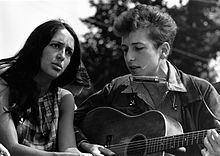 Bob Dylan and Joan Baez during the civil rights "March on Washington for Jobs and Freedom", August 28, 1963
Bob Dylan and Joan Baez during the civil rights "March on Washington for Jobs and Freedom", August 28, 1963
The large musical, political, lifestyle, and counterculture changes most associated with "the 60s" occurred during the second half of the 1960s and the first year or two of the 1970s. Folk music underwent a related rapid evolution and expansion at that same time. Large changes occurred through the evolution of established performers such as Bob Dylan, Joan Baez, Judy Collins, The Seekers and Peter Paul and Mary, and also through the creation of new fusion genres with rock and pop. Dylan's use of electric instruments helped inaugurate the genres of folk rock and country rock, particularly by his album John Wesley Harding. The Seekers emerged in 1963 and blended traditional music, contemporary folk music and pop, an illustration of the rapid evolution and diversification of folk music than began in the mid 1960s. These changes represented a further departure from traditional folk music. The Byrds with hits such as Seeger's "Turn, Turn, Turn" were emblematic of a new term folk rock. Marianne Faithfull began as a folk music performer in 1964 but became known only after switching to other genres. Other performers such as Simon & Garfunkel and The Mamas & the Papas created new hard-to-classify music that is folk inspired or styled. Folk singers and songwriters such as Phil Ochs, Buffy Sainte-Marie, Arlo Guthrie and Tom Paxton followed in Woody Guthrie's footsteps, writing "protest music" and topical songs and expressing support for various causes including the American Civil Rights Movement and anti-war causes associated with the Vietnam War. Bonnie Koloc is a Chicago-based American folk music singer-songwriter who made her recording debut in 1971. The Canadian performers Gordon Lightfoot, Leonard Cohen, Bruce Cockburn and Joni Mitchell represented such fusions and were all invested with the Order of Canada. Many of the acid rock bands of San Francisco began by playing acoustic folk and blues. The Smothers Brothers television shows featured many folk performers, including formerly blacklisted ones such as Pete Seeger and Harry Belafonte.[46]
The late 1960s saw the advent of electric folk groups. This is a form of folk rock, with a focus on indigenous (European, and, emblematically, English) songs. A key electric folk moment was the release of Fairport Convention's album Liege and Lief. Guitarist Richard Thompson declared that the music of the band demanded a corresponding "English Electric" style, while bassist Ashley Hutchings formed Steeleye Span in order to pursue a more traditional repertoire performed in the electric folk style. Exponents of electric folk music such as Fairport Convention, Pentangle, Alan Stivell and Mr. Fox saw electrification of traditional musical forms as a means to reach a far wider audience.
Mid 1970s through present day
Malicorne, a French electric folk group emerged in 1973, starting with traditional music and then later blended it with pop. Stan Roger's wrote and performed folk music with strong historical nautical themes, emerging in 1976. Si Kahn emerged in 1974 at the more political and topical end of the folk music spectrum.
In the 1980s, artists like The Knitters propagated cowpunk or folk punk, which eventually evolved into alt country. More recently the same spirit has been embraced and expanded on by artists such as Dave Alvin, Miranda Stone and Steve Earle.
Starting in the 1970s it was fueled by new singer-songwriters such as Steve Goodman, John Prine who emerged in the early 1970s. The Pogues who emerged in the early 1980s and Ireland's The Corrs who emerged in the 1990s brought traditional tunes back into the album charts. Carrie Newcomer emerged with Stone Soup in 1984 and individually in 1991.
In the second half of the 1990s, once more, folk music made an impact on the mainstream music via a younger generation of artists such as Eliza Carthy, Kate Rusby and Spiers and Boden. Hard rock and heavy metal bands such as Korpiklaani, Skyclad, Waylander and Finntroll meld elements from a wide variety of traditions, including in many cases instruments such as fiddles, tin whistles, accordions and bagpipes. Folk metal often favours pagan-inspired themes. Viking metal is defined in its folk stance, incorporating folk interludes into albums (e.g., Bergtatt and Kveldssanger, the first two albums by once-folk metal, now-experimental band Ulver).
Specialty sub-genres
Filk music can be considered folk music stylistically and culturally (though the 'community' it arose from, science fiction fandom, is an unusual and thoroughly modern one).[47] Neofolk began in the 1980s, fusing traditional European folk music with post-industrial music, historical topics, philosophical commentary, traditional songs and paganism. The genre is largely European.
Anti folk began in New York City in the 1980s. Folk punk, known in its early days as rogue folk, is a fusion of folk music and punk rock. It was pioneered by the London-based Irish band The Pogues in the 1980s. Industrial folk music is a characterization of folk music normally referred to under other genres, and covers music of or about industrial environments and topics, including related protest music.
Other sub-genres include Indie folk, Techno-folk, Freak folk and Americana and fusion genres such as folk metal, progressive folk, psychedelic folk, and neofolk.
Notable venues
The Philadelphia Folk Festival is a four-day festival which began in 1962. It is sponsored by the non-profit Philadelphia Folksong Society. The event hosts contemporary and traditional artists in genres including World/Fusion, Celtic, Singer/Songwriter, Folk Rock, Country, Klezmer, and Dance. It is held annually on the third weekend in August. The event now hosts approximately 12,000 visitors, presenting bands on 6 stages.
The Newport Folk Festival is an annual folk festival held near Newport, Rhode Island. It ran most year from 1959 to 1970, and 1985 to the present, with an attendance of approximately 10,000 persons.
It is sometimes claimed that the earliest folk festival was the Mountain Dance and Folk Festival, 1928, in Asheville, North Carolina, founded by Bascom Lamar Lunsford. Sidmouth Festival began in 1954, and Cambridge Folk Festival began in 1965. The Cambridge Folk Festival in Cambridge, England is noted for having a very wide definition of who can be invited as folk musicians. The "club tents" allow attendees to discover large numbers of unknown artists, who, for ten or 15 minutes each, present their work to the festival audience.
Stan Rogers is a lasting fixture of the Canadian folk festival Summerfolk, held annually in Owen Sound, Ontario, where the main stage and amphitheater are dedicated as the "Stan Rogers Memorial Canopy". The festival is firmly fixed in tradition, with Rogers' song "The Mary Ellen Carter" being sung by all involved, including the audience and a medley of acts at the festival.
The Canmore Folk Music Festival is Alberta's longest running folk music festival. The Feast of the Hunters' Moon in Indiana draws approximately 70,000 visitors per year.
Folk music is popular among some audiences today, with folk music clubs meeting to share traditional-style songs, and there are major folk music festivals in many countries, e.g. the Woodford Folk Festival, National Folk Festival and Port Fairy Folk Festival are amongst Australia's largest major annual events, attracting top international folk performers as well as many local artists.
Urkult Näsåker, Ångermanland held August each year[48] is purportedly Sweden's largest world-music festival.
See also
- List of folk festivals
- Ethnomusicology
- Roud Folk Song Index
- World music
- Indigenous music
- Canadian Folk Music Awards
Notes & References
- ^ a b Ruehl, Kim. "Folk Music". About.com definition. http://folkmusic.about.com/od/glossary/g/FolkMusic.htm. Retrieved August 18, 2011.
- ^ a b c d e f g Percy Scholes, The Oxford Companion to Music, OUP 1977, article "Folk Song".
- ^ A.L.Lloyd, Folk Song in England, Panther Arts, 1969, p. 13.
- ^ Richard Middleton, Studying Popular Music, Philadelphia: Open University Press (1990/2002). ISBN 0-335-15275-9, p. 127.
- ^ a b Ronald D. Cohen Folk music: the basics (CRC Press, 2006), pp. 1-2.
- ^ a b International Folk Music Council definition (1954/5), given in Lloyd (1969) and Scholes (1977).
- ^ Charles Seeger (1980), citing the approach of Redfield (1947) and Dundes (1965), quoted in Middleton (1990) p.127.
- ^ Donaldson, 2011 page 13
- ^ a b A. L. Lloyd, Folk Song in England, Panther Arts, 1969, pp. 14-5.
- ^ Middleton, Richard 1990, p. 127. Studying Popular Music. Milton Keynes; Philadelphia: Open University Press. ISBN 0-335-15276-7 (cloth), ISBN 0-335-15275-9 (pbk)
- ^ a b c Mills, Isabelle (1974). http://cjtm.icaap.org/content/2/v2art5.html The Heart of the Folk Song, Canadian Journal for Traditional Music Vol. 2
- ^ Charles Seeger (1980) quoted in Middleton (1990) p. 127.
- ^ http://www.youtube.com/watch?v=Hr9FP93o8Ro Alan Lomax's 1947 Documentary narrated by Pete Seeger
- ^ A.L.Lloyd, Folk Song in England, Panther Arts, 1969
- ^ Quoted by both Scholes (1977) and Lloyd (1969).
- ^ Bodley24 OX.ac.uk
- ^ Alison Vardy, et al., About Traditional Music Page, Celtic Harp Sheet Music site. Accessed 16 February 2007.
- ^ Donaldson, 2011 page 13
- ^ Donaldson, 2011 p 20
- ^ Donaldson, 2011, p 22-23
- ^ Donaldson, 2011, p 24-26
- ^ Donaldson, 2011, p 32-37
- ^ Donaldson, 2011, p37
- ^ GCSE Music - Edexcel Areas of Study, Coordination Group Publications, UK, 2006, page 34, quoting examination board syllabus.
- ^ a b Kerry O'Brien December 10, 2003 7:30 Report, abc.net.au
- ^ G. Smith, Singing Australian: A History of Folk and Country Music (Pluto Press Australia, 2005), p. 2.
- ^ Who'll come a waltzing Matilda with me?", The National Library of Australia, retrieved 14 March 2008.
- ^ Wilurarra Creative (2010). Music
- ^ a b Sawyers, June Skinner (2000). Celtic Music: A Complete Guide. Da Capo Press. ISBN 0-306-81007-7.
- ^ Kaminsky, David (2005) pages 33-41. "Hidden Traditions: Conceptualizing Swedish Folk Music in the Twenty-First Century." Ph.D. Dissertation, Harvard University.
- ^ Jersild,Margareta (1976) pages 53-66. "Om förhållandet mellan vokalt och instrumentalt i svensk folkmusik. Svensk tidskrift för musikforskning 58(2): 53-66. (Swedish)
- ^ a b Ted Olson, "Music — Introduction". Encyclopedia of Appalachia (Knoxville, Tenn.: University of Tennessee Press, 2006), pp. 1109—1120.
- ^ Heatley, Michael (2007). The Definitive Illustrated Encyclopedia of Rock. London, United Kingdom: Star Fire. ISBN 978 1 84451 996 5.
- ^ a b c d e http://www.thecanadianencyclopedia.com/index.cfm?PgNm=TCE&Params=A1ARTU0001240 An article on folk music from the Encyclopedia of Music in Canada
- ^ www.balladtree.com/folk101/001a_def.htm Definitions of folk music by Hugh Blumenfeld, www.balladtree.com
- ^ Traditional songs - Folk song lyrics of the world
- ^ Library of Congress. Related Material - Woody Guthrie Sound Recordings at the American Folklife Center. Retrieved on November 27, 2007.
- ^ University of Virginia: Crossroads: Woody Guthrie [1]
- ^ a b Spivey, Christine A. This Land is Your land, This Land is My Land: Folk Music, Communism, and the Red Scare as a Part of the American Landscape. The Student Historical Journal 1996–1997, Loyola University New Orleans, 1996.
- ^ Cultural Equality - Alan Lomax profile Burl Ives (1909–1995) by Ellen Harold and Peter Stone
- ^ Peter Dreier, "Pete Seeger Deserves One More Honor -- the Nobel Peace Prize"The Huffington Post 5/4/09.
- ^ David King Dunaway, How Can I Keep From Singing?
- ^ a b Clarke, SP, "Odetta- American Folk Music Pioneer"
- ^ Rubeck, Shaw, Blake et al., The Kingston Trio On Record (Naperville IL: KK Inc, 1986), p. 11 ISBN 978-0961459406
- ^ Eder, Bruce. "Biography of The Kingston Trio". AllMusic Guide. http://www.allmusic.com/artist/p2038/biography. Retrieved July 17, 2009.
- ^ Bianculli, David (2009). Dangerously Funny: The Uncensored Story of the Smothers Brothers Comedy Hour. New York: Touchstone (Simon & Schuster). pp. 130–134, 193–196. ISBN 9781439101162.
- ^ Definition of filk by FilkOntario
- ^ http://www.urkult.se/
References
These are the references with multiple abbreviated cites with varying page numbers
- Donaldson, Rachel Clare, 2011 Music for the People: the Folk Music Revival And American Identity, 1930-1970, Ph.D. Dissertation, Vanderbilt University, May, 2011, Nashville, Tennessee
Further reading
(does not include those used as references)
Traditional folk music
- Bayard, Samuel Preston (1950). "Prolegomena to a Study of the Principal Melodic Families of British-American Folksong", Journal of American Folklore pp. 1–44. Reprinted in McAllester, David Park (ed.) (1971) Readings in ethnomusicology New York: Johnson Reprint. OCLC 2780256
- Bearman, C. J. (2000). "Who Were the Folk? The Demography of Cecil Sharp's Somerset Folk Singers." The Historical Journal (September 2000) Vol. 43 No.3 pp. 751–75. JSTOR 3020977
- Bevil, Jack Marshall (1984). Centonization and Concordance in the American Southern Uplands Folksong Melody: A Study of the Musical Generative and Transmittive Processes of an Oral Tradition. PhD Thesis, North Texas University, Ann Arbor: University Microfilms International. OCLC 12903203
- Bevil, Jack Marshall (1986). "Scale in Southern Appalachian Folksong: a Reexamination", College Music Symposium Vol. 26, 77-91.[verification needed]
- Bevil, Jack Marshall (1987). "A Paradigm of Folktune Preservation and Change Within the Oral Tradition of a Southern Appalachian Community, 1916-1986." Unpublished. Read at the 1987 National Convention of the American Musicological Society, New Orleans.
- Bronson, Bertrand Harris. The Ballad As Song (Berkeley: University of California Press, 1969).
- Bronson, Bertrand Harris. The Singing Tradition of Child's Popular Ballads (Princeton: Princeton University Press, 1976).
- Bronson, Bertrand Harris. The Traditional Tunes of the Child Ballads, with Their Texts, According to the Extant Records of Great Britain and North America, 4 volumes (Princeton and Berkeley: Princeton University and University of California Presses, 1959, ff.).
- Cartwright, Garth (2005). Princes Amongst Men: Journeys with Gypsy Musicians. London: Serpent's Tail. ISBN 1852428775
- Carson, Ciaran (1997). Last Night's Fun: In and Out of Time with Irish Music. North Point Press. ISBN 9780865475151
- Cowdery, James R. (1990). The Melodic Tradition of Ireland. Kent, OH: Kent State University Press. ISBN 9780873384070
- Farsani, Mohsen (2003) Lamentations chez les nomades bakhtiari d'Iran. Paris: Université Sorbonne Nouvelle.
- Harker, David (1985). Fakesong: The Manufacture of British 'Folksong', 1700 to the Present Day. Milton Keynes [Buckinghamshire]; Philadelphia: Open University Press. ISBN 0335150667
- Jackson, George Pullen (1933). White Spirituals in the Southern Uplands: The Story of the Fasola Folk, Their Songs, Singings, and "Buckwheat Notes". Chapel Hill: University of North Carolina Press. LCCN 33-003792 OCLC 885331 Reprinted by Kessinger Publishing (2008) ISBN 9781436690447
- Matthews, Scott (2008). "John Cohen in Eastern Kentucky: Documentary Expression and the Image of Roscoe Halcomb During the Folk Revival". Southern Spaces. http://southernspaces.org/2008/john-cohen-eastern-kentucky-documentary-expression-and-image-roscoe-halcomb-during-folk-revival. (August 6)[page needed]
- Karpeles, Maud. An Introduction to English Folk Song. 1973. Oxford. Oxford University Press.
- Keller, Marcello Sorce (1984). "The Problem of Classification in Folksong Research: A Short History", Folklore Vol. 95, no. 1:100–104. JSTOR 1259763
- Poladian, Sirvart. "Melodic Contour in Traditional Music," Journal of the International Folk Music Council III (1951), 30-34.
- Poladian, Sirvart. "The Problem of Melodic Variation in Folksong," Journal of American Folklore (1942), 204-211.
- Rooksby, Rikky, Dr Vic Gammon et al. The Folk Handbook. (2007). Backbeat
- Sharp, Cecil. Folk Song: Some Conclusions. 1907. Charles River Books
- Sharp, Cecil English Folk Songs from the Southern Appalachians. Collected by Cecil J. Sharp. Ed. Maud Karpeles. 1932. London. Oxford University Press.
- Warren-Findley, Jannelle (1980). "Journal of a Field Representative : Charles Seeger and Margaret Valiant" Ethnomusicology, Vol. 24, No. 2 (May, 1980), pp. 169–210 JSTOR 851111
Contemporary folk music
- Cantwell, Robert. When We Were Good: The Folk Revival. Cambridge: Harvard University Press, 1996. ISBN 0-674-95132-8
- Cohen, Ronald D., Folk music: the basics, Routledge, 2006.
- Cohen, Ronald D., A history of folk music festivals in the United States, Scarecrow Press, 2008
- Cohen, Ronald D. Rainbow Quest: The Folk Music Revival & American Society, 1940-1970. Amherst: University of Massachusetts Press, 2002. ISBN 1-55849-348-4
- Cohen, Ronald D., ed. Wasn't That a Time? Firsthand Accounts of the Folk Music Revival. American Folk Music Series no. 4. Lanham, Maryland and Folkstone, UK: The Scarecrow Press, Inc. 1995.
- Cohen, Ronald D., and Dave Samuelson. Songs for Political Action. Booklet to Bear Family Records BCD 15720 JL, 1996.
- Cray, Ed, and Studs Terkel. Ramblin Man: The Life and Times of Woody Guthrie. W.W. Norton & Co., 2006.
- Cunningham, Agnes "Sis", and Gordon Friesen. Red Dust and Broadsides: A Joint Autobiography. Amherst: University of Massachusetts Press, 1999. ISBN 1-55849-210-0
- De Turk, David A.; Poulin, A., Jr., The American folk scene; dimensions of the folksong revival, New York : Dell Pub. Co., 1967
- Denisoff, R. Serge. Great Day Coming: Folk Music and the American Left. Urbana: University of Illinois Press, 1971.
- Denisoff, R. Serge. Sing Me a Song of Social Significance. Bowling Green University Popular Press, 1972. ISBN 0-87972-036-0
- Denning, Michael. The Cultural Front: The Laboring of American Culture in the Twentieth Century. London: Verso, 1996.
- Dunaway, David. How Can I Keep From Singing: The Ballad of Pete Seeger. [1981, 1990] Villard, 2008. ISBN 0-306-80399-2
- Eyerman, Ron, and Scott Barretta. "From the 30s to the 60s: The folk Music Revival in the United States". Theory and Society: 25 (1996): 501-43.
- Eyerman, Ron, and Andrew Jamison. Music and Social Movements. Mobilizing Traditions in the Twentieth Century. Cambridge University Press, 1998. ISBN 0-521-62966-7
- Filene, Benjamin. Romancing the Folk: Public Memory & American Roots Music. Chapel Hill: The University of North Carolina Press, 2000. ISBN 0-8078-4862-X
- Goldsmith, Peter D. Making People's Music: Moe Asch and Folkways Records. Washington, DC: Smithsonian Institution Press, 1998. ISBN 1-56098-812-6
- Hajdu, David. Positively 4th Street: The Lives and Times of Joan Baez, Bob Dylan, Mimi Baez Fariña and Richard Fariña. New York: North Point Press, 2001. ISBN 0-86547-642-X
- Hawes, Bess Lomax. Sing It Pretty. Urbana and Chicago: University of Illinois Press, 2008
- Jackson, Bruce, ed. Folklore and Society. Essay in Honor of Benjamin A. Botkin. Hatboro, Pa Folklore Associates, 1966
- Lieberman, Robbie. "My Song Is My Weapon:" People's Songs, American Communism, and the Politics of Culture, 1930-50. 1989; Urbana: University of Illinois Press, 1995. ISBN 0-252-06525-5
- Lomax, Alan, Woody Guthrie, and Pete Seeger, eds. Hard Hit Songs for Hard Hit People. New York: Oak Publications, 1967. Reprint, Lincoln University of Nebraska Press, 1999.
- Lynch, Timothy. Strike Song of the Depression (American Made Music Series). Jackson: University Press of Mississippi, 2001.
- Middleton, Richard (1990). Studying Popular Music. Milton Keynes; Philadelphia: Open University Press. ISBN 0-335-15276-7 (cloth), ISBN 0-335-15275-9 (pbk).
- Reuss, Richard, with [finished posthumously by] Joanne C. Reuss. American Folk Music and Left Wing Politics. 1927-1957. American Folk Music Series no. 4. Lanham, Maryland and Folkstone, UK: The Scarecrow Press, Inc. 2000.
- Rubeck, Jack; Shaw, Allan; Blake, Ben et al. The Kingston Trio On Record. Naperville, IL: KK, Inc, 1986. ISBN 978-0-9614594-0-6
- Scully, Michael F. (2008). The Never-Ending Revival: Rounder Records and the Folk Alliance. Urbana: University of Illinois Press.
- Seeger, Pete. Where Have All the Flowers Gone: A Singer's Stories. Bethlehem, Pa.: Sing Out Publications, 1993.
- Willens, Doris. Lonesome Traveler: The Life of Lee Hays. New York: Norton, 1988.
- Weissman, Dick. Which Side Are You On? An Inside History of the Folk Music Revival in America. New York: Continuum, 2005. ISBN 0-8264-1698-5
- Wolfe, Charles, and Kip Lornell. The Life and Legend of Leadbelly. New York: Da Capo [1992] 1999.
Covering both traditional music and contemporary folk music
- Pegg, Carole (2001). "Folk Music". The New Grove Dictionary of Music and Musicians, edited by Stanley Sadie and John Tyrrell. London: Macmillan.
- van der Merwe, Peter (1989). Origins of the Popular Style: The Antecedents of Twentieth-Century Popular Music. Oxford: Clarendon Press. ISBN 0-19-316121-4.
External links
- The World and Traditional Music section at the British Library Sound Archive
- The Traditional Music in England project, World and Traditional Music section at the British Library Sound Archive Dead link
- The Mudcat Cafe and Digital Tradition song database
- Encyclopedia of Oklahoma History and Culture - Folk Music
- The Crooked Road: Heritage music trail-A 243-mile historical music oriented trail.
- Folk Alley A Non-Profit Listener Supported Folk Music Resource, Streaming online since 2004
- Traditional songs - Folk song lyrics of the world
- Ben Gray Lumpkin Digital Folk Music Collection Howard B. Waltz Music Library, University of Colorado Boulder
- Free scores of Folk music in the Choral Public Domain Library (ChoralWiki)
- Free scores (songs) at www.traditional-songs.com
Folk music Subgenres Ballads · Carols · Children's songs · Drinking song · Hornpipe · Jigs · Morris dance · Protest song · Sea shanties · War songs
Fusions Anti-folk · Celtic music · Celtic rock · Country folk · Electric folk · Filk music · Folk metal · Folk punk · Folk rock · Folktronica · Indie folk · Industrial folk song · Manila Sound · Medieval folk rock · Neofolk · Nu-folk · Psych folk · Progressive folk · Skiffle · Techno-folk · Un-folkRelated articles Festivals · Folk clubs · Folk dance · Instruments · Lists of traditions · Pub session · Record labels · Roots revival · Singer-songwriter · Traditional music · World music
Regional scenes American roots music - African American music
- Appalachian music
- Blues (Ragtime)
- Cajun music
- Country (Bluegrass, Country and Western, Honky-tonk, Rockabilly, Western swing)
- Creole music
- Folk music revival (1950s-60s)
- Jazz (Dixieland)
- Native American
- Negro spirituals and Gospel
- Old-time music
- Swamp pop
- Tejano
- Zydeco
Categories:
Wikimedia Foundation. 2010.


